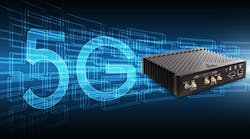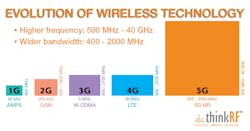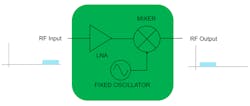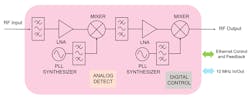Cost-Effective RF Analysis in the 5G mmWave Bands
What You’ll Learn:
- The greater analysis challenges posed to RF engineers by the shift to mmWave 5G frequencies.
- How the limitations of basic RF downconversion hamper analysis efforts in the lab and field.
- How a more sophisticated RF downconverter/tuner can absorb test-setup complexity.
After years of research and testing, 5G wireless networks are being deployed in cities around the world. Leveraging mmWave frequencies well above previously used bands, 5G wireless promises rapid speeds, wide bandwidths, near real-time latencies, and extremely high capacities.
However, these high-frequency signals create unique challenges for mobile operators, RF equipment providers, researchers, and RF engineers conducting RF analysis in the field. Deploying and optimizing 5G networks will require more extensive testing, propagation analysis, and coverage mapping to ensure performance. It’s critical to quickly identify and resolve RF interference or other sources of disruption. Meanwhile, engineers need ongoing remote monitoring and drive tests to maintain reliable connectivity for users.
RF downconverters/tuners provide a portable, easy-to-use, and economical solution to these requirements by boosting the performance of existing spectrum-analysis equipment into the 5G frequency realm. Rather than replacing current test-and-measurement equipment, users can integrate an RF downconverter with existing equipment to extend its range into millimeter-wave (mmWave) signals for applications such as data recording, spectrum monitoring, signal analysis, RF drive test, and RF research and development.
By taking this approach, users are able to conduct analysis and testing when deploying and optimizing 5G networks. Compared to upgrading to new hardware, users reduce capital expenses, minimize additional training for engineers in the field, and maintain their current test setups and equipment.
The Changing Requirements for 5G Wireless
From the early 1G networks of the 1980s through the 4G/LTE networks most of us connect to every day, each generation of wireless technology boosted performance, functionality, and coverage. However, while performance and bandwidth increased with every new standard, the frequencies of operation for each standard generally remained the same. Mobile networks have typically operated at bands below 6 GHz. As a result, the equipment used to analyze these signals was designed to capture signals up to 6 GHz as well.
5G wireless, on the other hand, is expected to operate in different bands depending on the application and performance requirements (Fig. 1). Low- and mid-band signals under 6 GHz will continue to be used in rural environments or other applications where range, penetrability, and coverage are more important than speed or bandwidth. These bands will also be important as mobile operators leverage existing 3G/4G/LTE infrastructure to build out their 5G networks.
However, the real 5G experience will be delivered with networks currently operating in the mmWave bands ranging from 24 to 40 GHz. These high-frequency signals will be used in dense, urban environments or other applications that require increased speed, bandwidth, and capacity.
The propagation characteristics of these high-band signals are less well understood, and higher-frequency signals are more impacted by barriers such as buildings, walls, trees, and even people. Mobile operators will therefore need to conduct extensive testing and optimization as they deploy mmWave 5G networks.
This means that mobile operators are left with a choice: They can decide to replace their existing equipment with spectrum analyzers that capture up to 40 GHz; or they can choose to extend the life and performance of their existing hardware by integrating with an RF downconverter/tuner.
In most cases, especially in the near and medium term, mobile operators will want to reduce costs, deploy equipment and networks more rapidly, reduce training requirements for engineers in the field, and maximize the ROI of their current equipment by integrating with an RF downconverter.
The Challenges of a Basic Approach to RF Downconversion
RF downconverters extend the performance of existing analysis equipment by capturing high-frequency signals and converting them to a lower range. By integrating with a downconverter, a spectrum analyzer can process signals that would otherwise be outside of its frequency range.
It’s possible to build a simple downconverter with only a few components. As shown in Figure 2, a basic downconverter can be designed using a low-noise amplifier (LNA), a mixer, and a fixed oscillator.
While this approach may be simple, it ultimately creates more challenges for users because it enables only block downconversion. The downconverter shifts the entire frequency range that it captures into a block of spectrum, which is then input into the analyzer operating over a lower-frequency range.
For example, a 24- to 40-GHz RF downconverter designed using this simple approach captures a 16-GHz block of spectrum. The 24-GHz band is converted to dc, while the 40-GHz band is converted to 16 GHz. A 6-GHz analyzer would be unable to process the entire block of downconverted spectrum.
Even if the signal of interest falls within the range of the analyzer, a simple approach raises additional challenges. Because every LNA and mixer has gain characteristics that change with frequency, the downconverted signal would not be calibrated. This makes it impossible to see key signal properties, such as the amplitude of the signal at the RF input port.
Similarly, due to the lack of any front-end filtering, there’s the risk of creating spurious signals or increasing the noise floor to a level where the signal of interest is hidden.
Finally, an approach using off-the-shelf components requires a large form factor and complex integration. Extensive RF expertise is required to successfully integrate equipment, while the increased size, weight, and power requirements make the combined solution unsuitable for field applications.
Making a Move to More Sophistication
Rather than taking this simple approach, it’s far better for operators to integrate with a more sophisticated RF downconverter/tuner that takes on more complexity in the unit itself. With expanded capabilities and better performance, the user gets a simple, easy-to-use, and economical solution.
One such example of a commercially produced downconverter is the thinkRF D4000 RF downconverter/tuner, which outputs to a single IF frequency centered at 1.5 GHz. The user simply tunes their receiver or spectrum analyzer to 1.5 GHz, tunes the D4000 to the desired frequency of interest between 24 and 40 GHz, and processes the signal using their existing equipment and test setup.
To provide this level of performance and ease of use, the thinkRF D4000 analyzer hides a lot of complexity from the user. Gain blocks optimize the signal for the best possible noise figure, while built-in tunable local oscillators and pre-select filtering reject out-of-band signals that would result in spurs or interference (Fig. 3). This eliminates the need for external synthesizers and enables interference hunting or other low-power, over-the-air, signal-detection applications.
Calibration also enables accurate signal measurement and easy integration with calibrated equipment. Compared to the simple approach, amplitude and other properties at the RF input are known based on the signal out of the downconverter/tuner, enabling more accurate and in-depth analysis.
Extending Performance into 5G Wireless
5G wireless networks promise to bring in a new era of innovation and technology. A high-speed, reliable network is critical as more technologies and applications depend on 5G networks.
However, 5G technologies introduce new challenges for mobile operators, RF equipment providers, researchers, and RF engineers. As mobile operators deploy, test, and optimize these networks, they need to increase the performance of their existing spectrum analysis and test-and-measurement equipment.
Dr. Nikhil Adnani is Chief Technology Officer and VP Sales at thinkRF.



